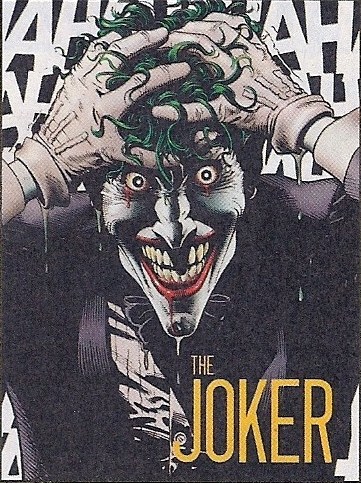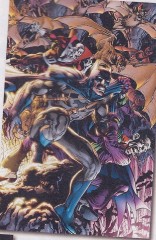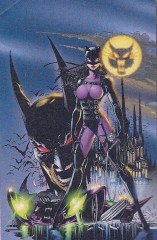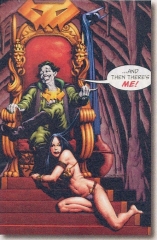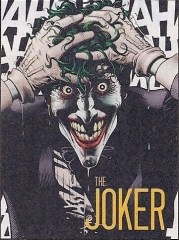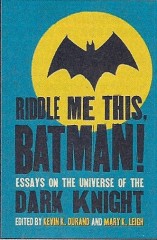This is an excerpt from an article by Lou Anders published in Batman Unauthorized. The complete title is TWO OF A KIND: Can the Team Behind Batman Begins Capture the Essence of the Joker?“ Bear in mind that this book came out a few months before the movie came out as rumors were leaked on the web of Heath Ledger having being selected to portray the crazy villain.
Note: This article does not reflect ideas, thoughts, or any way the point of view of the poster or this community. It is included here as a source of information
…so who is this Joker and where did he come from?
The Harlequin of Hate, as he sometimes called, was first introduced in Batman vs The Joker in Batman #1, spring 1940. In his first appearance, he was a deadly serious murderer, who announced his intended victim’s fates and dared the police to stop him. He was ghastly, ghostly, nothing to laugh about. In fact, he racked up quite a body count in his first twelve appearances, killing almost thirty people before sent to the electric chair. But the Joker developed a knack for cheating seeming-deaths, and this was far from the ond for the character, despite being originally conceived as a one-off. However, the editors of Batman began to fear that leaving a murderer on the loose undermined the Detective’s image, and so instituted a policy of only letting one-shot villains kill. For this and other reasons, the Joker was softened, dwindling into a clownish buffoon more interested in pranks than killing sprees. In fact he wasn’t even officially crazy. There was actually a comic in which the resolution involved Batman and Robin temporarily convincing the Joker he was going mad. “The Crazy Crime Clown” (Batman #74) saw the Joker placed in a padded cell, but ended with Bruce Wayne musing, “I see where the Joker’s recovered from the confusing night we gave him! They are transferring him to the state prison!” To which Dick Grayson replied, “Yes– he finally had to tell the authorities where Derek’s money was hidden in order to prove that he himself was sane!” To prove he was SANE? Are you sure?
The character then disappeared almost entirely for much of the 1960’s, and it wasn’t until the aforementioned Denny O’neil and Neal Adams run in a now famous story in 1973 entitled “The Joker’s Five Ways Revenge” (Batman #251), that he was returned to the level of a serious and murderous threat. It was in this issue that his lack of sanity was established. When he was incarcerated, we learn that it was not in Gotham Penitentiary as previous tales had it, but in a place called Arkham Asylum for the Criminally Insane (The name is a nod to the horror fiction of H.P. Lovecraft, Arkham being a fictional Massachusetts city that features heavily in his horror writings about the Cthulhu mythos).
The notion that the Ace of Knaves is “criminally insane” was given more depth in the Steve Englehart and Marshal Rogers run in a1978 story entitled “The Laughing Fish” (Detective Comics #475 and #476) which combined a deliberate reworking of the Joker’s original 1940’s appearance with a severely demented personality. To date, this issue remains one of the best portrayals of the character’s madness. Superman writer Kurt Busiek, in an article in Wizard Magazine, remembers, “Hands down, the best Joker bit ever, to my mind, is when he tries to copyright fish…It’s such a demented thing to do, but he persues it so intently, so matter-of-factly–pausing only to wonder if it might not work because people might stop eating fish, but reasoning that vegetarians would not go for it–that really makes him feel like a madman, rather than like a criminal with daffy overtones” (quoted in “Joker comics”)
From that point forward, the Joker was always depicted as being, if you will pardon the pun, batshit crazy. But it was Alan Moore’s landmark novel The Killing Joke that truly established the definite version of the character, retelling his origin story while allowing for differences in continuity. As the character said of his history, “Sometimes I remember it one way, sometimes another…if I’m going to have a past, I prefer it to be multiple choice!” Despite some confusion as to his former life, the idea that the Joker suffered a personal tragedy beyond just his physical scarring and equal to Bruce Wayne’s own loss was introduced as an explanation for the character’s madness. As recounted here, that tragedy was the death of his wife and unborn child. In this story, Joker shot Barbara Gordon in the stomach, paralyzing her for life, then kidnapped and brutalized her father Commissioner James Gordon, forcing him to look at photographs of his naked and traumatized daughter in an effort to drive him insane, an attempt to prove that anyone can have “one bad day” and become as the joker is now.
This unprecedented graphic violence escalated post-Killing Joke, with the Joker going on to murder Jason Todd, the second Robin, as well as Commissioner Gordon’s second wife, Sarah Essen. By 2007, the Joker was indisputably one of the most dangerous and insane villains in DC’s entire Universe. This is in evidence in the 1995 three issue Underworld Unleashed, in which Flash-nemesis, the Trickster said, “When supervillains want to scare each other, they tell Joker stories.”
So in the same way that we have crafted a definite Batman (In Batman Begins), we can come up with a set of guidelines for what a definite portrayal of the Ace of Knaves should look like?
To begin with the obvious: The Joker is dangerously insane. Far from being Cesar Romero in greasepaint and armed with a joy buzzer, this is Charles Manson meets Hannibal Lecter. A modern portrayal of the Joker needs to understand this and show us someone truly terrifying, worthy of the villain said to have killed more than 2,000 people, including, as recounted in a 1996 issue of Hitman, an entire kindergarten class. In short, he needs to be truly frightening.
Secondly, and this is minor but please indulge me, the Joker’s face is not fixed in a grin. True the character was modeled on Conrad Veidt from the 1928 film, The Man Who Laughs, based on the novel by Victor Hugo, about a boy whose face is mutilated into a permanent smile. Bob Kane and Bill Finger took inspiration for the Joker’s look from the character, but nowhere was it on record that his face was fixed. This misassumption found its way into the 1989 film in which the Joker’s face is frozen from a gunshot wound, but had stayed out of the comics until just this year, when Grant Morrison introduced the heresy in Batman 663, Nolan and Goyer will know better and won’t saddle Heath Ledger with any cumbersome and unnecessary prosthetics
But most important is that the Joker is the one person who truly understands the complex nature of the Batman’s code against killing. In fact, he is the single character in the Batman mythos who understands this as well as Batman himself, who grasps how tight a line it is that the hero walks and who knowingly pours as much pressure on his lline as he can in a calculated effort to force Batman to cross over.
In Frank Miller’s, “The Dark Knight Returns”, the Batman says, “I’ll count the dead, one by one. I’ll add them to the list Joker. The list of all the people I’ve murdered–by letting you live…” (117). For his part, while poisoning a troop of boys scouts, the Joker says, “They could put me in a helicopter and fly my up in the air and line the bodies head to toe on the ground in delightful geometric patterns like an endless June Taylor dancer’s routine–and it would not be enough. No, I don’t keep count. But you do. And I love you for it” (1 40). His “affection” for the Batman, whom he calls “darling” more than once, comes precisely from the knowing how much mayhem he causes wounds the other man. He knows exactly what he is doing, tormenting the Batman with his crimes, deliberately attempting to force the Batman to take a life preemptively. Finally in the end, when Batman broke his neck, but failed to do so with enough pressure to kill him, he chided, “I’m really…very disappointed with you my sweet…the moment was…perfect… and you…didn’t have the nerve…Paralysis…really…they’ll kill you for this… and they’ll never know…that you didn’t have the nerve…” (150-151). And the Batman lamented, “voices calling me a killer…I wish I were (150). The Joker finished himself off, and as the Batman hobbled away, the clown’s corpse seems to mock him for his lack of nerve.
But why this game? Why does Joker so desperately want to die at Batman’s hands? For that we have to turn to Alan Moore’s The Killing Joke. When explaining his rationale for brutalizing Barbara Gordon and then forcing her father to witness the footage, the Joker said, “You see, it doesn’t matter if you catch me and send me back to the asylum…Gordon’s been driven mad. I’ve proven my point. I’ve demonstrated there’s no difference between me and everyone else! All it takes is one bad day to reduce the sanest man alive to lunacy. That’s how far the world is from where I am. Just one bad day.”
Most of us don’t hinge our entire sense of sanity on one single facet of character. We don’t anchor our identity on a single razor’s edge. But the Batman does. Taking the methods of a criminal—breaking and entering, assault, vigilantism, etc—into his hands, the line he has drawn is his only self-justification, his only proof that the darkness has not completely swallowed him. But if the Joker can get the Batman to bend, just once, he can prove that anyone, even a person towering force of will, will snap if subjected to enough pressure—i.e., the Joker himself is blameless of his crimes, as he was just someone who snapped after a sufficient amount of tragedy. In The Further Adventures of the Joker, in a story by Mark L. Van Name and Jack McDevitt called “Happy Birthday,” Joker tried to demonstrated this once again. He calls in favors and threats all over town, pouring criminals onto the street, subjecting Gotham to a week of utter chaos. This takes predictable toll on the Caped Crusader. Then, at the culmination, he disguises himself as a cop and dresses a kidnapped cop as the Joker. Accompanying Batman on a raid, he asks the Dark Knight if he shouldn’t just do the the world a favor and pull the trigger, and for a moment, the Batman considers. Then Batman sees through the game. But at the story’s conclusion, the Joker remarks, “So I won that one. And sometimes at night, when the moon is high, and I know he’s out there, I feel a little better. The distance between us isn’t as great as it used to be.” (290)
This is spelled again in “The Clown at Midnight” (Batman #663): “You can’t kill me without becoming like me. I can’t kill you without losing the only human being who can keep up with me. Isn’t it ironic?!” Later in the issue, he mused, “I could never kill you. Where would the act be without my straight man?”
Grant Morrison’s Arkham Asylum is, even in Morrison’s admission, not a great portrayal of Batman, but it does get one thing right about the Joker. At the graphic novel’s resolution, the Batman agrees with the Joker and acknowledges the necessity of his own insanity. The result? The Joker is satisfied. Having finally gotten the admission he’s always wanted, she shuts everything down, surrenders, and walks Batman out of Arkham with an arm around his shoulder, promising him, “Enjoy yourself out there. In the Asylum. Just don’t forget—if it gets too tough…there’s always a place for you here.”
Just like Batman, the Joker has something to prove. Their motivations are locked like opposite poles of a magnet. That Batman draws back such a clear line in the sand is irresistible to a psyche desperate to see only shades of grey. He’s willing to murder the entire world if that is what it takes to make the Dark Knight relinquish his last, tenuous, and tiny finger-hold on dainty. His own salvation rests on proving his point. If Nolan, Nolan, and Goyer understand even half of this, we’ll be alright. Given their track record, I suspect we will be, and the most famous supervillain in the history of comics will finally be given his full cinematic due. After all, when you have this level of material to draw upon, anything else would be crazy.

